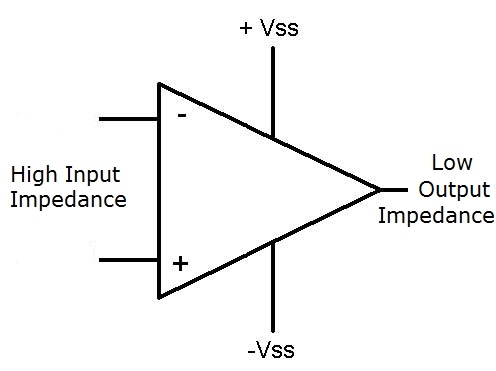Why Does an Op Amp Have a High Input Impedance and a Low Output Impedance?

Op Amp is a Voltage Gain Device
Op amps have high input impedance and low output impedance because of the concept of a voltage divider, which is how voltage is divided in a circuit depending on the amount of impedance present in given parts of a circuit.
Op amps are voltage gain devices. They amplify a voltage fed into the op amp and give out the same signal as output with a much larger gain. In order for an op amp to receive the voltage signal as its input, the voltage signal must be dropped across the op amp.
If you know the concept of a voltage divider, voltage drops primarily across components with high impedances, proportionally according to ohm's law by the formula V=IR. So the greater the resistance (or impedance) of a device, the greater the voltage drop across that device is. To make sure that the voltage signal drops fully on the op amp, it must have a very high input impedance, so that the voltage drops fully across it. If it had a low input impedance, the voltage may not drop across it and it would not receive the signal. This is why op amps must have high-input impedances.
For the same reason of a voltage divider, an op amp needs a low output impedance. Once the voltage is dropped across the op amp and it does its task of amplifying the signal, the signal should get dropped across the device that the op amp should feed. For example, say we have a microphone circuit. The signals spoken into the microphone need amplification from an op amp so that they can reach a level that can drive speakers. When the signals are amplified now, they are to be dropped across the speakers. Thus, the speakers must be of greater impedance than the output of the op amp, so that the voltage signals will drop across the speakers. Thus, the op amp needs a very low output impedance, so that the amplified voltage signal drops across the speakers and not the op amp. If not, the the amplified voltage signals will fall across the output impedance of the op amp and only partially on the speakers. The speakers will barely receive any signal and, thus, will not play back or output anything. This is way, op amp needs low output impedances, so that it can drop its amplified voltage signals across the desired device effectively and not on itself.
To Prevent Loading
Another reason op amps need high input impedance is because the loading effect. If op amps had very low input impedance, it would draw significant amounts of current into it. Thus, it would be a large load on the circuit. This would be a dangerous situation. The fact that an op amp has a high input impedance ensures that it consumes very little current from the circuit and doesn't cause a loading issue in the circuit in which it demands and sucks up large amounts of current of the circuit. Thus, as it's high impedance, it acts as a small load. The high impedance ensures that it draws very little current. It is the amplifier's task to convert a low energy, voltage-driven signal into a higher-voltage output signal.
It may seem ironic that a very high impedance device is a small load, but according to ohm's law, I=V/R, the larger the resistance of a device,
the smaller the current
that it demands. Low impedance circuits can be dangerous because of the high current draw that they produce. Op amps
avoid this by having very high input impedance. And, thus, because the current is low on the input, it doesn't transfer over to the output and is also low on the output.
Thus, an op amp is a low-current, high-voltage gain device.
Note: If op amps were low input impedance devices, large current would flow from the power source to the op amp. The fact that current would flow
from the source to the amplifier would also make the signal more vulnerable to the characteristics of the cable or wire that
connect the two. Thus, if the cable or wire is very noisy or is susceptible to picking up or producing noise, the signal fed into the op amp would be much be
noisy and produce a noisier signal. This is another design issue why op amps function better as high impedance
devices.
Related Resources
What is an Ideal Op Amp?
Why Does an Op Amp Need a Power Supply?
What is the Difference Between a Single and Dual Supply Op Amp?
How to Connect a LM741 Op Amp Chip to a Circuit
Voltage Follower
Unity Gain Buffer
Isolation Amplifier
Op Amp Gain Calculator
